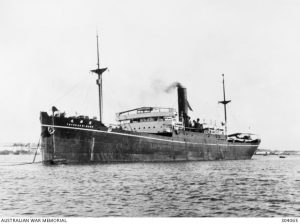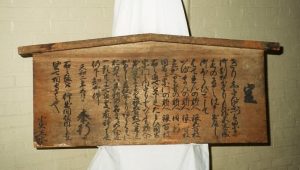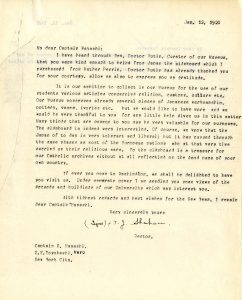
(Courtesy of the Australian War Memorial)
Author Katherine Santa Ana served as Graduate Library Pre-Professional (GLP), 2015-2017.
December of 1919, Captain K. Hayashi arrived at the piers of Staten Island aboard his ship, the Tayohashi Maru. A Catholic himself, Captain K. Hayashi brought with him the latest acquisition of The Catholic University of America’s museum collection: an anti-Christian signboard, known as kōsatsu 高札. Found in Kobe, Japan by the missionary Father Perrin, then rector of the University Rev. Thomas J. Shahan purchased the signboard for the museum collection for thirty dollars.
Dating from 1682, this signboard details the laws against Christianity in Japan, rewards for turning in a Christian to the authorities, as well as punishment for the offenders. While the first Christian missionary came to the island around 1549, Catholicism was subsequently banned in 1587 by the “Bateren-tsuiho-rei” (the Purge Directive Order to the Jesuits) issued by Toyotomi Hideyoshi, Imperial Regent of Japan. Christianity and powerful missionaries were viewed as a threat to the recently unified country. With the Catholic clergy expelled from Japan completely in the mid-17th century, many Japanese Catholics practiced their faith in secret as government officials publicly posted boards like these around Japan.

Along with the signboard, Father Perrin provided the following translation:
“The Christian religion has already been prohibited for many years. Everyone who gives ground for suspicion must be denounced, the following rewards are hereby promised.
To the informer against a Priest, 500 pieces of silver.
To the informer against a Brother, 300 pieces of silver.
To the informer against a Relapse, 300 pieces of silver.
To the informer against a Guest or an ordinary Christian, 100 pieces of silver.
If the informer is himself a guest or a co-religionist (Christian) he will receive 500 pieces of silver. The chief of the section and the group of the five families of the district concerned will be punished jointly with the concealer, if the whereabouts of the culprits are discovered otherwise than through them.
Second year of Tenwa, fifth moon, 1682 June. The Governor. Let all the inhabitants of this Province obey this order. Koide Mondo.”

At roughly 40 inches long and 16 inches wide, the signboard has a shallow peaked “roof” to protect the calligraphy from the rain. In the translation, “Relapse” refers to a former Catholic who has resumed practicing Christianity, while “Guest” refers to anyone staying with a Christian. The last phrase on the signboard, “Koide Mondo,” is the name of the governor of the region.
The Japanese Christians who continued to practice in secret during the time of persecution were known as Kakure Kirishitan 隠れキリシタン , literally “hidden Christians.” Christianity remained illegal until the mid-19th century, when imperial rule returned to Japan during the Meiji Restoration. While many of these secret Christians emerged and began practicing publicly, a few decided to continue to practice in secret, even to today.
Signboards similar to this one can be found in the collections of the Burke Library at Union Theological Seminary, Columbia University in New York and Sophia University in Tokyo and represent one piece of the fascinating history of Christianity in Japan. The signboard at The Catholic University of America is currently on display in the office of the University Archivist.
